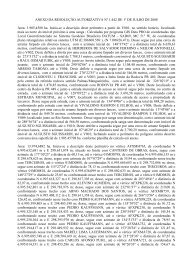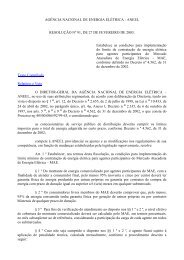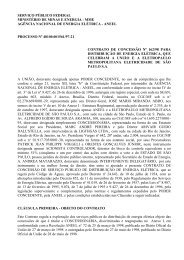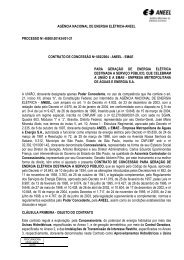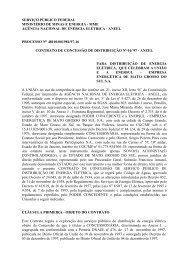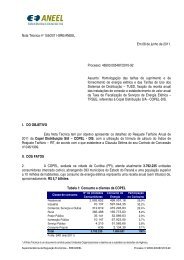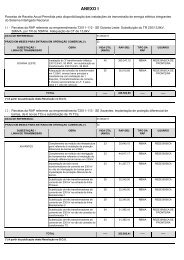RESERVOIR SEDIMENTATION ASSESSMENT GUIDELINE - Aneel
RESERVOIR SEDIMENTATION ASSESSMENT GUIDELINE - Aneel
RESERVOIR SEDIMENTATION ASSESSMENT GUIDELINE - Aneel
You also want an ePaper? Increase the reach of your titles
YUMPU automatically turns print PDFs into web optimized ePapers that Google loves.
Reservoir Sedimentation Assessment GuidelineThe average diameter for the sediment particles required for building the shieldmight be computed through several methods, being one considered as the verification ofthe other. Each method shall report a different shield diameter, thus requiringexperience when evaluating the most suitable option. Basic data for computationsrequire:• sampling of bed material along the reach being surveyed, as well as in differentheights along the entire zone where degradation may occur;• selection of the main discharge, usually adopted as the discharge peak with twoyears of recurrence;• channel’s average hydraulics features corresponding to the selected main discharge,obtained from the computation of uniform backwater runoff throughout the selectedriver reach.Following, are presented four methods for computing the diameter D c .Use of the bed capable velocity – Several laboratory surveys have evidenced that thediameter of a particle taken from bed is proportional to the velocity of the stream nearbythe bed. The velocity in which the particle starts its movement is considered as the bedcapable velocity, V b , which was observed to be approximately equivalent to 0,7 timesthe average velocity for the channel V m :V b = 0,7 V m (13.5)Figure 13.4 represents the bed capable velocity V b in relation to the diameter of amobile sediment particle, and has been used to determine the shield thickness.Figure 13.4 – Bed capable velocity in relation to the average diameter of thetransportable sediment (Strand, 1974)ANEEL – Brazilian Electricity Regulatory Agency / SIH – Hydrologic Studies and Information Department81



